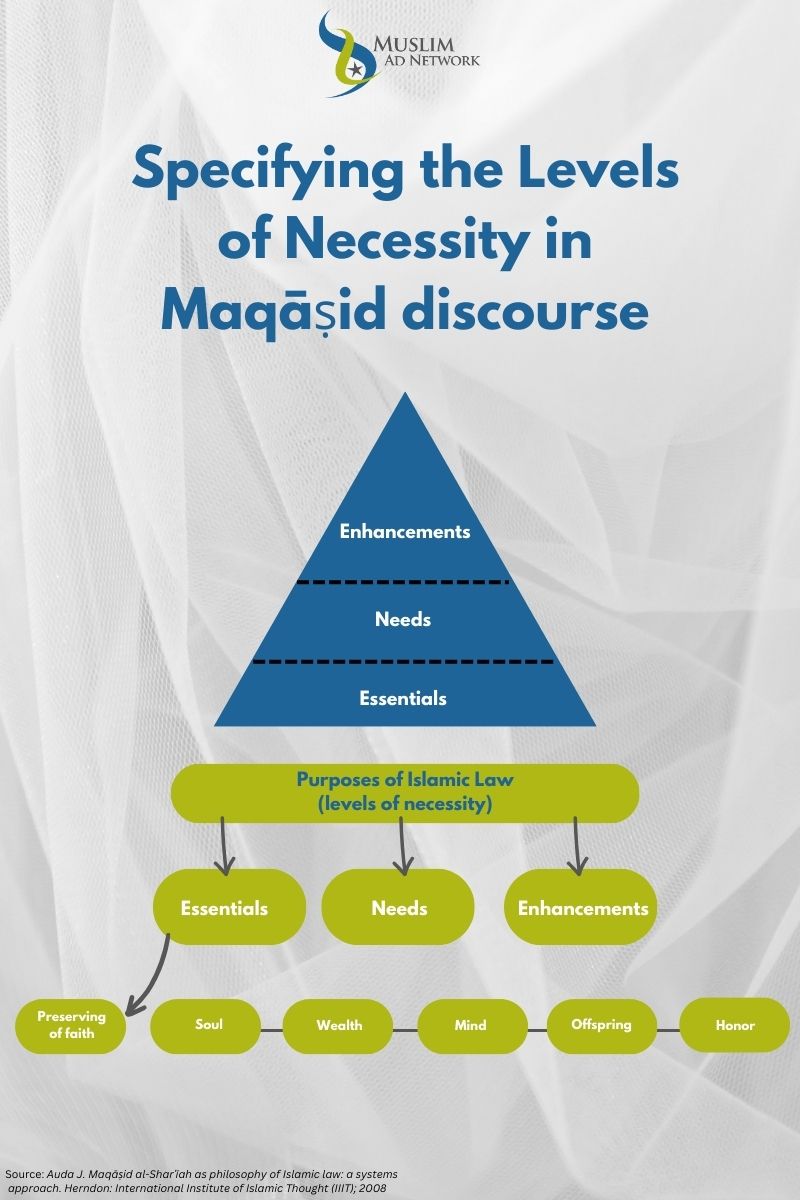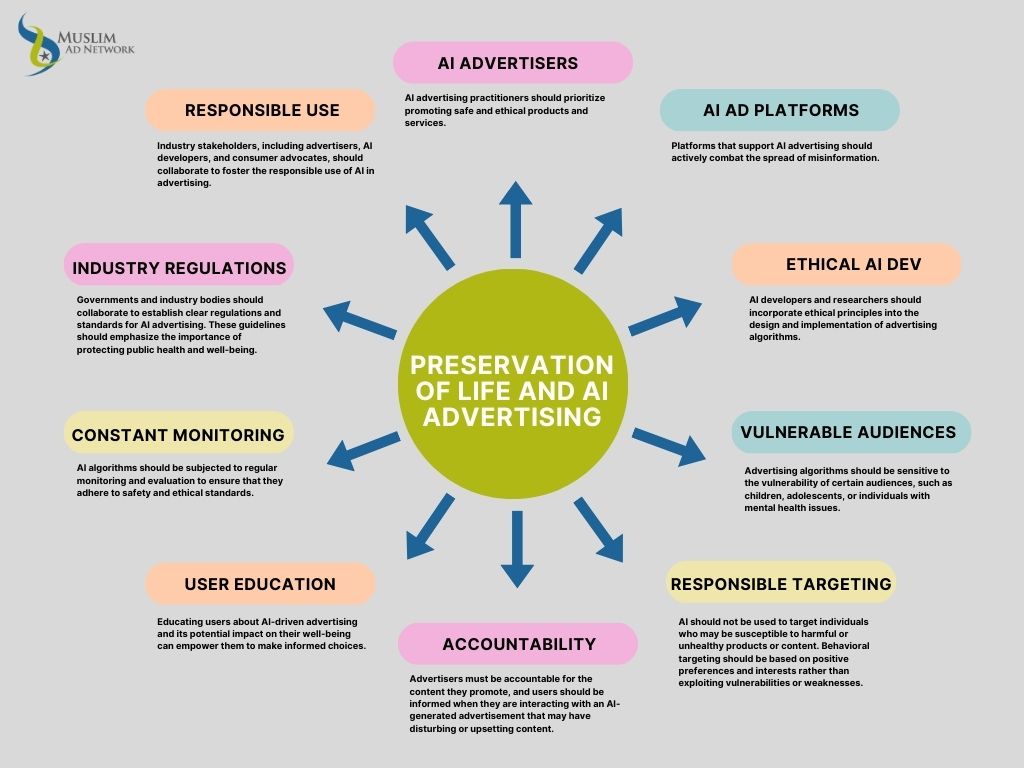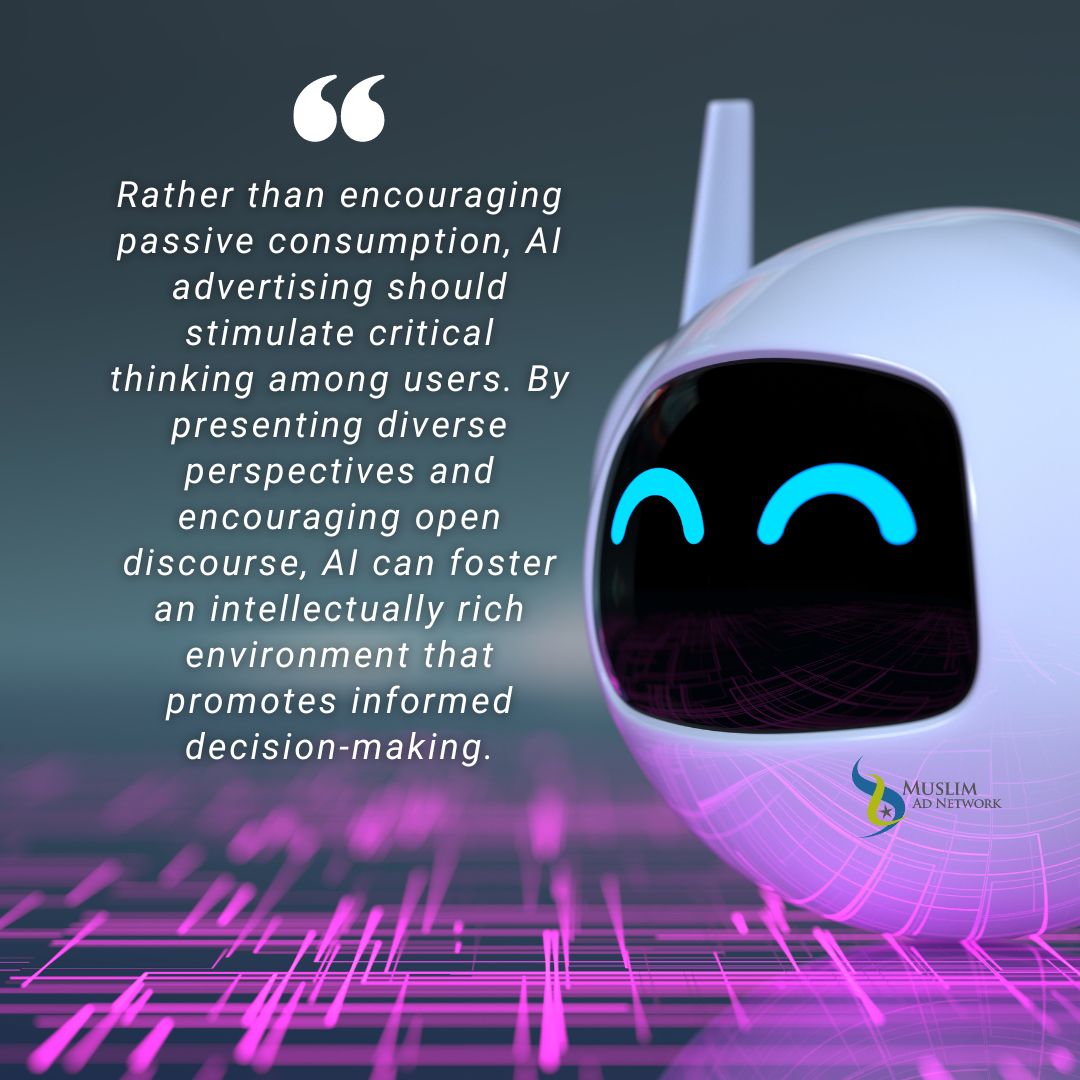
In the first of this two-part artificial intelligence (AI) ethics series, we scrutinized the ethical concerns related to the utilization of AI and examined prospective solutions and frameworks to alleviate AI risks and moral dilemmas from an Islamic viewpoint. If you haven’t already, we recommend you read the first part of our two-part article first, to get the full picture.
In this subsequent part, we delve further into the implementation of those solutions and frameworks. As mentioned in the first part we have based the foundation of this article on the research paper, “Islamic virtue-based ethics for artificial intelligence”.
Maqāṣid-based Ethics for Technology
The most important focus is on the essential objectives (necessity) in any situation. Amana Raquib, in her book “Islamic ethics of technology: an objectives (Maqāṣid) approach”, introduced an ethical framework for technology based on Islamic Maqāṣid. This framework emphasizes a comprehensive analysis, recognizing that contemporary technology can have a profound impact on cultures, worldviews, ideas, and even the understanding of harms and benefits. The framework identifies various necessities (ḍarūrāt) for human society, derived from the Islamic tradition, and organizes them under five key objectives developed by classical Muslim scholars.
Let’s look at the levels of necessity in Maqāṣid discourse for a clearer understanding:

The Islamic Maqāṣid framework, derived from the Qurʾān and Sunnah (ways of the Prophet peace be upon him), guides over 2 billion Muslims worldwide. It prioritizes the preservation of essential objectives like religion, life, progeny, property, and intellect. With a hierarchical structure, essentials come before needs and enhancements. The framework varies based on circumstances, favoring the community’s well-being. Some scholars emphasize community-focused objectives, while others include justice, freedom, and honor. The Maqāṣid framework offers adaptable ethical principles, ensuring the well-being of individuals and the community.
AI Advertising and Essentials
At the core of the Maqāṣid framework are the essential objectives, known as ḍarūrāt, which are absolute necessities. These objectives include religion (dīn), life (nafs), progeny (nasl), property or wealth (māl), and intellect (aql). The preservation of these objectives is of utmost importance, and anything that poses a threat to them is strongly prohibited. The Maqāṣid framework significantly emphasizes these essential objectives as the foundation for ethical decision-making.
Relating the Maqāṣid framework to artificial intelligence advertising, we can explore how this ethical framework could be applied to ensure the responsible and beneficial use of AI in advertising.
Disclaimer: The below is not a conclusion drawn from the agreement of Islamic scholars but rather an effort from MAN based on the research paper this article is based on and our experience in the world of advertising.
1. Religion (Dīn)
In the context of AI advertising, the religious aspect could relate to respecting individuals’ beliefs and values. AI algorithms should be trained not to promote content that is offensive, discriminatory, or against religious principles. Advertisements should be sensitive to diverse cultural and religious backgrounds, avoiding content that could provoke religious tensions or undermine people’s faith.
Stamford University recently published the Artificial Intelligence Index Report 2023. It shows that AI is biased when it produces outputs that reinforce and perpetuate stereotypes that harm specific groups.
According to Hubspot who authored The State of AI in Marketing in 2023, you can do the following to mitigate AI bias in marketing and advertising:
- Human oversight: Monitor outputs, analyze data, and correct bias to ensure fairness. For example, marketers can review generative AI outputs before using them in marketing materials.
- Assess potential bias: Evaluate AI use cases for higher potential prejudice, like banking institutions using historically biased data.
- Invest in AI ethics: Continued investment in AI research and ethics to develop concrete strategies for reducing bias.
- Diversify AI: The inclusion of diverse perspectives helps create unbiased practices, enabling recognition and mitigation of bias.
- Acknowledge human bias: Recognize and address personal biases to ensure AI remains unbiased, such as using representative sample sizes in research.
- Be transparent: Build trust by disclosing the use of AI, such as adding a note to AI-generated news articles.
2. Life (Nafs)
AI advertising, like any application of artificial intelligence, carries both potential benefits and risks. The preservation of life and well-being is indeed crucial in this context, as it’s essential to ensure that AI algorithms used in advertising do not engage in harmful practices that negatively impact people’s health and safety.

Let’s elaborate on this perspective:
- AI Advertising Practitioners: AI advertising practitioners should prioritize promoting safe and ethical products and services. The algorithms need to be designed in a way that avoids endorsing items that can pose health risks or harm to consumers. This includes items such as counterfeit pharmaceuticals, dangerous dietary supplements, or products that lack proper safety standards.
- AI Advertising Platforms: Platforms that support AI advertising should actively combat the spread of misinformation. Misleading health claims, deceptive marketing, and unproven treatments can have severe consequences for people’s well-being. AI algorithms must be equipped to detect and avoid disseminating false information.
- Ethical AI Development: AI developers and researchers should incorporate ethical principles into the design and implementation of advertising algorithms. This includes prioritizing human values, fairness, and harm reduction in the decision-making process of AI systems.
- Protecting Vulnerable Audiences: Advertising algorithms should be sensitive to the vulnerability of certain audiences, such as children, adolescents, or individuals with mental health issues. Content that may encourage self-harm or promote harmful behavior should be strictly avoided.
- Responsible Ad Targeting: AI should not be used to target individuals who may be susceptible to harmful or unhealthy products or content. Behavioral targeting should be based on positive preferences and interests rather than exploiting vulnerabilities or weaknesses.
- Transparency and Accountability: AI advertising systems should be transparent in their operations. Advertisers must be accountable for the content they promote, and users should be informed when they are interacting with an AI-generated advertisement that may have disturbing or upsetting content.
- User Education: Educating users about AI-driven advertising and its potential impact on their well-being can empower them to make informed choices. This could involve clear labeling of AI-generated content and providing easy-to-access information about advertisers’ ethical practices.
- Continuous Monitoring and Evaluation: AI algorithms should be subjected to regular monitoring and evaluation to ensure that they adhere to safety and ethical standards. Constant updates and improvements are essential to stay ahead of potential risks to vulnerable audiences.
- Industry Regulations and Standards: Governments and industry bodies should collaborate to establish clear regulations and standards for AI advertising. These guidelines should emphasize the importance of protecting public health and well-being.
- Collaboration and Responsible Use: Industry stakeholders, including advertisers, AI developers, and consumer advocates, should collaborate to foster the responsible use of AI in advertising. Open dialogue and sharing best practices help ensure the technology benefits society without compromising well-being.
AI advertising has the potential to offer personalized and relevant content to users. However, the preservation of life and well-being is of utmost importance in this domain. It is crucial to develop and implement AI advertising systems with strong ethical principles, transparency, and accountability to avoid promoting harmful products, spreading misinformation, or endangering the health and safety of users.
3. Progeny (Nasl)
In advertising with AI, the focus on progeny is of paramount importance as it involves protecting the well-being and best interests of children, who are a particularly vulnerable demographic. Advertising strategies driven by AI should be ethical, responsible, and considerate of the impact they have on young audiences. Here are some perspectives on AI advertising concerning progeny and kids:
- Age-Appropriate Content: AI algorithms should be programmed to ensure that advertisements are suitable for the intended age group. Content that contains explicit or inappropriate material for children should be filtered out to create a safe advertising environment for young audiences.
- Protecting Privacy: Data collection from minors must be handled with utmost care and comply with strict regulations. Advertisers and AI systems should never exploit children’s personal information or target them based on sensitive data.
- Parental Consent: Advertisers should obtain explicit consent from parents or legal guardians before collecting any data related to children. This ensures that parents have control over the information shared about their children and the advertising content they are exposed to.
- Educational and Positive Content: AI advertising can be utilized to promote educational content that nurtures learning and creativity in children. Advertisers should strive to create positive and inspiring campaigns that contribute positively to the growth and development of young minds.
- Avoiding Manipulation: AI algorithms should not use manipulative tactics to influence children’s behavior or desires. Advertisements targeted at kids should be transparent and avoid exploiting their cognitive vulnerabilities.
- Media Literacy for Children: Alongside advertising practices, efforts should be made to enhance media literacy among children. Teaching kids how to critically evaluate advertising messages empowers them to make informed decisions and resist potential manipulations.
- Diversity and Inclusivity: AI advertising should be sensitive to diversity and inclusion, ensuring that children from different backgrounds are equally represented and positively portrayed in advertisements.
- Monitoring and Oversight: Regular monitoring and oversight of AI-driven advertising campaigns can help identify and rectify any content that may be harmful to children. Industry self-regulation and external audits can contribute to maintaining ethical standards.
- Parental Controls: AI-powered platforms should provide parental control features, allowing parents to manage and filter the content their children are exposed to. This helps create a safer and more controlled advertising environment for young users.
- Collaborative Efforts: Governments, advertisers, tech companies, and child protection organizations should collaborate to set industry standards, guidelines, and best practices for AI advertising targeted at children. This joint effort can ensure that the focus on progeny is consistently prioritized across the advertising ecosystem.
AI advertising targeted at minors requires a heightened sense of responsibility and sensitivity. By prioritizing ethical considerations, promoting positive content, and protecting children’s privacy, AI-driven advertising can be a force for good, positively shaping the experiences of young audiences and safeguarding their well-being.
4. Property or Wealth (Māl)

In the modern digital landscape, AI-driven advertising has become a pivotal tool for businesses to reach their target audiences effectively. However, it is crucial for advertisers and AI algorithms to uphold ethical principles and prioritize users’ data privacy to maintain a healthy relationship with consumers.
Regarding property or wealth, AI advertising should respect users’ data privacy and not engage in unethical data practices. Advertisements should be relevant and valuable to users, but AI algorithms should not exploit personal data for excessive profit or violate users’ trust by sharing their information without consent.
Here’s an elaboration on how AI advertising should respect users’ data privacy and avoid unethical practices:
- Transparency and Consent: AI advertising practitioners should be transparent about the data they collect and the purpose of its usage. Users must provide informed consent before their data is utilized for ad targeting. Transparency helps build trust and empowers users to make informed decisions about sharing their information which today can be seen as wealth since it can be used as a commodity.
- Anonymization and Aggregation: AI algorithms should work with anonymized and aggregated data to ensure individual user identities remain protected. This approach allows advertisers to understand audience segments without compromising personal privacy, which one could argue is the most valuable asset one has.
- Ad Relevance and Value: AI algorithms can analyze user behavior, preferences, and past interactions to deliver ads that are genuinely relevant and valuable to users. This should be used to assure relevant ads are served responsibly that do not result in the user spending his or her wealth on zero-value purchases.
AI-powered advertising has the potential to deliver valuable and personalized experiences to users without sacrificing their data privacy or trust. When advertisers prioritize transparency, consent, relevance, and ethical data practices, they can create an advertising ecosystem that benefits both businesses and consumers alike. By respecting users’ data privacy, AI-driven advertising can thrive in an environment of mutual respect and understanding.
5. Intellect (ʿAql)

The aspect of intellect in the Maqāṣid framework relates to promoting knowledge, critical thinking, and informed decision-making. In AI advertising, this translates into presenting advertisements that are transparent, honest, and truthful. AI systems should not spread misinformation or manipulate users into making decisions that go against their best interests.
This principle is particularly relevant in the digital age, where AI-powered technologies play a significant role in shaping the information landscape and influencing consumer behavior.
Here’s how the aspect of intellect should guide AI advertising practices:
- Fact-Checking and Verification: To align with the Maqāṣid principle of promoting knowledge, AI systems used in advertising should prioritize fact-checking and verification. Algorithms must be designed to assess the accuracy and credibility of the content being promoted to prevent the dissemination of misinformation.
- Guarding Against Manipulation: AI algorithms must be developed with measures in place to avoid manipulating users into making decisions that are not in their best interests. For example, using psychological profiling to exploit vulnerabilities or create artificial urgency to drive impulsive purchases goes against thoughtful consumption of goods and services.
- Supporting Critical Thinking: Rather than encouraging passive consumption, AI advertising should stimulate critical thinking among users. By presenting diverse perspectives and encouraging open discourse, AI can foster an intellectually rich environment that promotes informed decision-making.
The aspect of intellect in the Maqāṣid framework provides valuable guidelines for AI advertising. By promoting knowledge, critical thinking, and informed decision-making, AI systems should prioritize transparency, honesty, and truthfulness. Guarding against misinformation and manipulation is crucial to ensure that AI advertising serves the best interests of users while maintaining ethical and responsible practices. By adhering to these principles, AI advertising can contribute to a more informed and empowered society in the digital age.
By incorporating the Maqāṣid framework into the development and deployment of AI advertising, we can foster an environment that prioritizes ethical values and ensures the well-being of individuals and society as a whole. Advertisements should serve as a means to provide value to users while respecting their rights, beliefs, and overall welfare. This approach to AI advertising aligns with the broader goal of using technology to positively impact people’s lives and preserve their essential objectives.
Needs and Enhancements
The Maqāṣid framework acknowledges not only the essentials for a decent life but also the presence of needs (ḥājiyyāt) and enhancements (taḥsīniyyāt). Needs refer to lesser necessities that provide support and complement essential objectives, while enhancements are desirable but optional requirements that add beauty or convenience to different aspects of life. In the hierarchy of the Maqāṣid framework, the preservation of the essentials is prioritized above needs and needs take precedence over enhancements.
The categorization of needs and enhancements in the Maqāṣid framework can be subject to change depending on individual and societal situations. This adaptability permits the framework to be flexible and cater to specific contexts while still ensuring the welfare of the community. Nonetheless, it is crucial to recognize that, in general, the well-being of the community is given precedence over that of the individual within this framework.
More on the Maqāṣid Framework
The Maqāṣid framework can be categorized according to the breadth and universality of its objectives. Certain Islamic scholars have emphasized the prioritization of Maqāṣid related to the well-being of the entire community (ummah) over those that primarily focus on individual interests. This community-centric approach ensures that ethical considerations encompass the overall welfare and benefit of society as a whole.
Furthermore, scholars engage in conversations regarding broadening the scope of the Maqāṣid to encompass principles like justice, freedom, and the preservation of honor. These principles are considered crucial for the welfare of both individuals and the community. Prominent Islamic figures like Sheikh Muhammad al-Ghazali have integrated justice and freedom as essential elements within the Maqāṣid framework, acknowledging their importance in establishing a fair and cohesive society.
The Maqāṣid framework presents Muslims with a practical ethical guide to navigate various life situations. It offers adaptable principles that help individuals make ethical decisions in accordance with the Sharʿīah. By prioritizing the preservation of essential objectives, the framework ensures that ethical choices align with the foundational values of Islam.
Furthermore, the Maqāṣid framework acknowledges the ever-changing nature of human life and allows for adaptation to different circumstances over time. This flexibility empowers individuals and communities to apply the framework in diverse contexts while remaining true to Islamic principles.
It’s important to understand that the Maqāṣid framework does not provide specific rules for every situation. Instead, it offers general ethical principles that guide Muslims in making morally informed choices. This adaptability permits individuals to exercise their judgment and apply the framework to various circumstances, as demonstrated in this article.
In conclusion, the Maqāṣid framework in Islamic ethics serves as a comprehensive guide for Muslims worldwide. It emphasizes the preservation of essential objectives, encompassing aspects such as religion, life, progeny, property, and intellect, and should be reflected in all aspects of life and business, including AI advertising.
start targeting muslim consumers